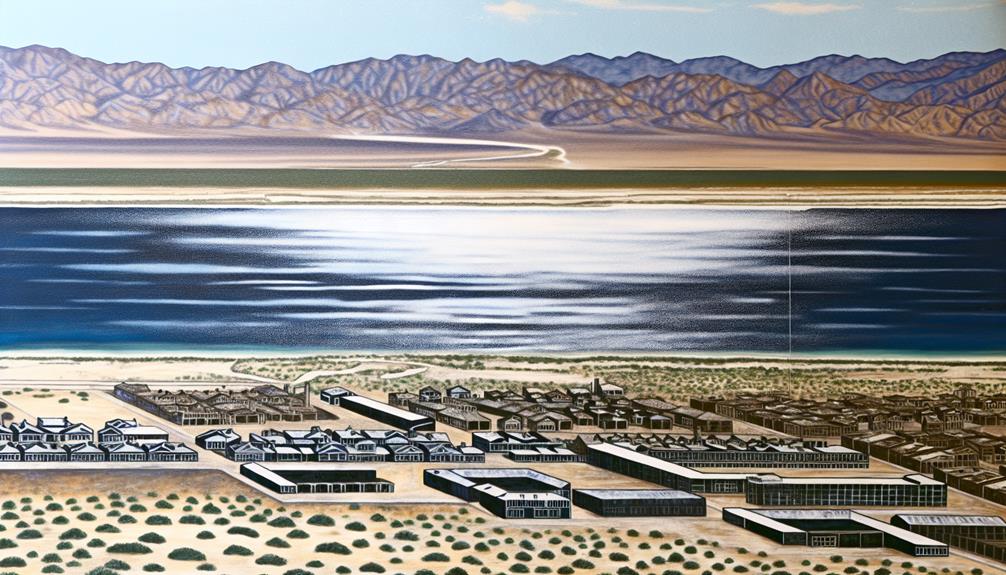The Salton Sea, nestled in the arid landscape of Southern California, invites exploration into a complex narrative that intertwines human intervention, ecological significance, and environmental challenges. As we investigate the history of this accidental yet fascinating body of water, a deeper understanding of its evolution and current state emerges. The interplay between conservation efforts, recreational opportunities, and the future sustainability of the Salton Sea raises thought-provoking questions about the delicate balance between human needs and the preservation of natural ecosystems.
Key Takeaways
- Formed in 1905 by Colorado River flooding.
- Critical bird habitat along the Pacific Flyway.
- Offers recreational activities like boating and bird watching.
- Faces environmental challenges like declining water levels.
- Sustainability requires efficient water management and conservation efforts.
History of the Salton Sea
The history of the Salton Sea can be traced back to a series of human-made events that led to the creation of this inland water body in California. Settlement patterns in the late 19th century saw ambitious attempts to divert water from the Colorado River into the Salton Sink for agricultural purposes. These efforts culminated in the accidental breaching of irrigation canals in 1905, resulting in the Colorado River flooding into the basin for two years, creating the Salton Sea.
The agricultural impact of the Salton Sea's formation was initially positive, leading to a boom in agricultural development in the surrounding areas. The fertile soil and abundant water supply attracted farmers, and the region became known for its citrus fruits, cotton, and other crops. Settlements sprang up around the sea, and resorts were built to cater to tourists attracted by the recreational opportunities offered by the newly formed body of water.
However, the rapid expansion of agriculture around the Salton Sea soon led to environmental issues. The increased use of fertilizers and pesticides resulted in runoff flowing into the sea, causing nutrient imbalances and algal blooms. These factors, combined with reduced water inflow due to the sea's high salinity levels, have contributed to the ecological challenges faced by the Salton Sea today.
Ecological Importance
With its diverse habitats and important role in supporting migratory birds, the Salton Sea holds significant ecological importance in the region. The sea serves as a pivotal bird habitat, particularly during the seasonal migrations of various avian species along the Pacific Flyway. Over 400 species of birds have been documented at the Salton Sea, making it a crucial stopover point for many migratory birds.
Wetland restoration efforts at the Salton Sea are essential for maintaining the ecological balance of the region. The wetlands surrounding the sea provide critical breeding grounds and resting places for numerous species of birds, including endangered and threatened ones. Restoring and preserving these wetlands is vital for the long-term health of the ecosystem and the biodiversity it supports.
The Salton Sea's ecological significance extends beyond its role as a bird habitat. The diverse array of plant and animal species that inhabit the area contribute to the overall richness of the ecosystem. Protecting these species and their habitats is important for maintaining the ecological integrity of the region.
As climate change continues to impact habitats worldwide, the preservation and restoration of the Salton Sea's ecological systems become increasingly significant. By prioritizing wetland restoration and habitat conservation efforts, stakeholders can make sure that the Salton Sea remains an essential ecological resource for years to come.
Recreational Activities and Tourism
A variety of recreational activities and tourism opportunities are available at the Salton Sea, attracting visitors from different regions to experience the unique environment. The Salton Sea, despite facing environmental challenges, remains a popular destination for outdoor enthusiasts. Water sports enthusiasts flock to the sea for activities such as boating, fishing, and jet skiing. The calm waters of the Salton Sea provide an ideal setting for these recreational pursuits, attracting both locals and tourists.
Another significant draw for visitors is the bird watching opportunities the Salton Sea offers. As a vital stopover point for migrating birds on the Pacific Flyway, the sea hosts a diverse array of bird species throughout the year. Bird watchers can spot pelicans, herons, egrets, and many other species in the wetlands surrounding the Salton Sea. This makes it a haven for bird enthusiasts seeking to observe and photograph unique avian species in their natural habitat.
In addition to water sports and bird watching, the Salton Sea region also offers camping, hiking, and picnicking opportunities for visitors looking to immerse themselves in the area's natural beauty. The combination of diverse recreational activities and the chance to witness the rich birdlife makes the Salton Sea a compelling destination for nature lovers and outdoor adventurers alike.
Environmental Challenges and Conservation Efforts
Addressing the pressing environmental challenges facing the Salton Sea requires a concerted effort towards implementing sustainable conservation strategies. The following key strategies are essential in tackling the environmental issues at the Salton Sea:
- Water Management:
Efficient water management is necessary to address the declining water levels and increasing salinity at the Salton Sea. Implementing water conservation measures, such as reducing agricultural runoff and increasing water recycling, can help maintain the ecological balance of the area.
- Habitat Restoration:
Rehabilitating and restoring habitats around the Salton Sea is crucial to support the diverse wildlife that depends on the ecosystem. Efforts to create and preserve wetlands, control invasive species, and protect nesting sites are important for the long-term health of the environment.
- Pollution Control:
Controlling pollution sources, such as agricultural runoff and industrial discharge, is essential to improving water quality at the Salton Sea. Implementing strict regulations and monitoring systems can help reduce contaminants and protect the ecosystem from further degradation.
- Community Engagement:
Involving local communities, environmental organizations, and government agencies in conservation efforts is key to ensuring the sustainability of conservation initiatives. Educating the public about the importance of preserving the Salton Sea and involving them in restoration projects can foster a sense of stewardship and collective responsibility for the environment.
Future Outlook and Sustainability
Efforts to guarantee the long-term sustainability of the Salton Sea ecosystem hinge on proactive planning and strategic interventions that address the evolving environmental landscape. The future development of the Salton Sea region is critically dependent on effective water management strategies. With increasing demands on water resources and the looming threat of climate change, sustainable water management practices are vital for the Salton Sea's future.
To safeguard the sustainability of the Salton Sea ecosystem, stakeholders must prioritize water management initiatives that balance the needs of agriculture, urban areas, and the environment. Implementing efficient irrigation techniques, investing in water recycling and desalination projects, and promoting water conservation measures are key components of sustainable water management in the region.
Furthermore, future development plans for the Salton Sea area should incorporate innovative solutions that address the challenges posed by changing environmental conditions. This may include restoring wetlands, enhancing habitat connectivity, and implementing adaptive management strategies to mitigate the impacts of climate change on the ecosystem.
Frequently Asked Questions
What Is the Impact of Geothermal Activity on the Salton Sea?
Geothermal energy, harnessed from the Earth's heat, has both positive and negative environmental impacts. While it is a renewable energy source that produces low greenhouse gas emissions, its extraction can cause land subsidence, induced seismicity, and water contamination.
The environmental consequences vary depending on the location and scale of geothermal activities. Understanding these impacts is essential for sustainable utilization of geothermal resources while minimizing harm to the environment.
Are There Any Endangered Species Unique to the Salton Sea Ecosystem?
Endangered species are vital indicators of ecosystem health, often necessitating targeted conservation efforts to guarantee their survival.
The presence of unique species in specific ecosystems, like the Salton Sea, underscores the importance of preserving biodiversity.
Understanding the habitat requirements and threats faced by these species is essential for effective conservation strategies.
How Does the Salton Sea Contribute to Local Agriculture?
Irrigation techniques play a pivotal role in optimizing crop yields and maintaining soil fertility. Water quality is an important factor in determining the success of agriculture in a region.
Crop rotation, a common practice in sustainable farming, helps prevent soil depletion and enhances overall agricultural productivity.
The integration of these elements can greatly impact local agriculture by ensuring efficient water use, healthy soil conditions, and sustainable crop production.
Is There a Risk of Earthquakes Affecting the Salton Sea Region?
Seismic activity poses a potential threat to the region in question, as fault lines run beneath the area. The possibility of earthquakes affecting the region cannot be discounted, and proactive measures may need to be considered to mitigate potential risks associated with such geological phenomena.
Studying the seismic activity and fault lines in the area can provide valuable insights into the likelihood and potential impact of earthquakes in this region.
What Measures Are Being Taken to Address Air Quality Issues Around the Salton Sea?
Air quality monitoring plays an important role in evaluating pollution levels and ensuring compliance with environmental regulations. These measures involve the continuous evaluation of air pollutants and their impact on public health and the environment.
Environmental regulations set standards for acceptable air quality levels and guide efforts to mitigate pollutants. By implementing robust monitoring systems and adhering to established regulations, authorities can address air quality issues effectively and safeguard the well-being of the community.
Conclusion
In summary, the Salton Sea in the USA stands as a critical ecosystem with a rich history and ecological significance. Despite facing environmental challenges, conservation efforts and sustainable water management practices are being implemented to guarantee its long-term viability.
The truth is that the future sustainability of the Salton Sea relies on continued collaboration and innovation to address its complex ecological issues.


